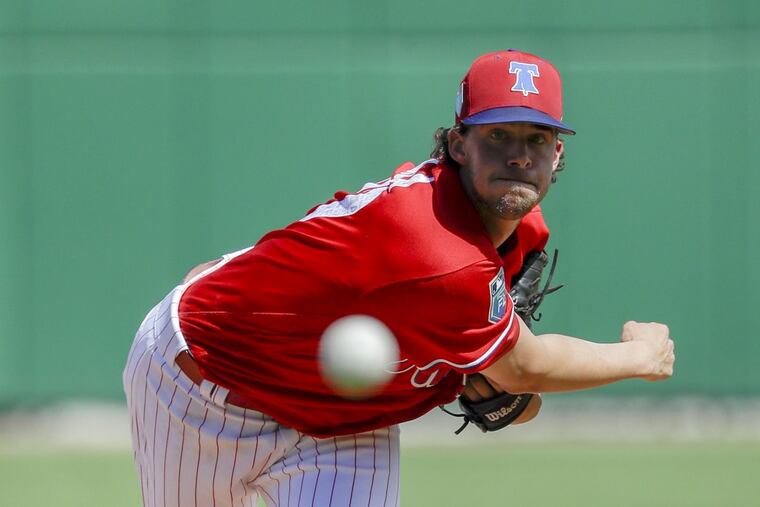How Phillies pitcher Aaron Nola developed one of baseball's best curveballs
Aaron Nola will take the mound Thursday as the youngest Phillies starter on opening day in 54 years. He has the potential to be one of baseball's elite young arms. His manager compared him to Zack Greinke.

CLEARWATER, Fla. — Aaron Nola will take the mound Thursday as the youngest Phillies starter on opening day in 54 years. He has the potential to be one of baseball's elite young arms. His manager compared him to Zack Greinke and his pitching coach said he's always in control.
Nola's path to Atlanta, to the front of the Phillies' starting rotation, was so rapid, following a 30-game sprint through the minor leagues and a quick assimilation to the majors. It is safe to assume that none of it would have been possible without a day of experimentation on a back field of an anonymous baseball complex on the east coast of Florida.
A month after the Phillies drafted Nola in June 2014, he was playing catch with high-A Clearwater's pitching coach before a road game in Jupiter, Fla. Nola's curveball, a pitch he favored in college, was troubled. The seams on a minor-league baseball were higher than those on the NCAA ball and Nola's trusted two-finger grip was now resulting in a hanging curveball that got hammered.
He needed something new. So Nola tried using just his index finger to dig into the baseball as he played catch with coach Bob Milacki. It felt weird, Nola said. But his throws to Milacki had the movement that Nola was searching for. One of baseball's best curveballs was born.
"I just started messing around with it," Nola said. "I'm glad I figured it out."
Nola threw his spike curveball — a curveball with sharp downward action — last season for more than 30 percent of his pitches. He threw the sixth most curveballs among all pitchers and opponents batted .172 against it, the 12th lowest mark among starting pitchers. The pitch seemed to get better as the season waned. Hitters batted just .103 in the season's final two months, the second lowest mark in that stretch.
A curveball is only as effective as its movement, and no curveball had more horizontal movement last season than Nola's. That movement comes from a high spin rate — Nola moves his index finger on his grip to alter spin — and a unique release point. His curveball came last season from the lowest vertical release point among any pitcher who made more than 12 starts. It is nearly a foot lower than the average as Nola fires his curveball with his arm almost fully extended outward.
"He comes from a little bit of a different angle. It's just different from a lot of guys," pitching coach Rick Kranitz said. "He's so comfortable with throwing that pitch. He's so consistent as far as release point. He can really spin a baseball and that's the biggest thing. He can really spin it. But him spinning it from where his angle is is even tougher for the hitter to see. It's just a different place. You don't see it from that angle much."
The curveball's effectiveness is also a result of Nola's ability to command the pitch and control himself. Catching Nola, Andrew Knapp said, is easy. There is nothing sporadic about his curveball, Knapp said. Nola knows where every pitch is going. And he seems to always contain his emotions on the mound, even as he dominates. Between innings, he asks questions in the dugout, wanting to know why hitters are laying off his curveball or why they're chasing borderline strikes.
"He wants to know because he's putting all that data in during the game," Kranitz said. "Some guys aren't able to do that."
It is not a surprise that Nola is starting on opening day less than four years after being drafted. Drafting him carried little risk — he was expected to be a quick mover. But it was the success he showed last summer — a 10-start stretch with two earned runs or fewer — that provided hope that Nola could be more than just a quick mover. He could be a front-line starter. His success stemmed from his curveball, which had never been more effective.
"It just kind of felt better," Nola said. "I feel really confident now. It feels normal."
Nola started the 2015 season in double A, nine months after he discovered the spike curveball on the back field in Jupiter. But he had yet to use it in a game. He had to find comfort with his new grip before shelving the old curveball that helped him become a first-round pick. He finally threw it in a road game at Erie and knew immediately that this was now his pitch.
"I got a guy to buckle a little bit," Nola said. "At the time, I wasn't getting any reactions on my old curveball. Guys were taking hacks at it. So I said 'OK. I'm going to keep throwing this and work on this pitch to get the control that I need to and the shape that I want to.' I'm glad I figured it out."
Those reactions followed Nola to triple A, where he harnessed the pitch's movement as it first cut across the plate like a slider. He soon reached the majors, 13 months after being drafted and 12 months after he experimented on that back field in Jupiter. Nola went to spring training this season as the obvious choice to start on opening day. And the reactions — the ones he first saw in Erie — came, too.
"It comes out of his hand like a fastball would and he spins it so well that the rotations make it look like a fastball," Knapp said. "Even when guys are standing and watching his bullpens, there like 'It's nasty.' "